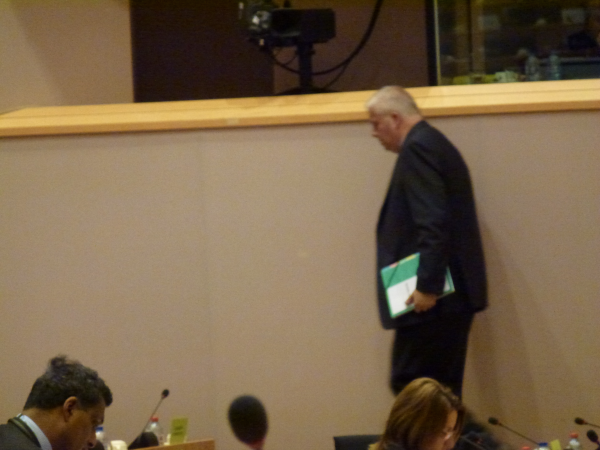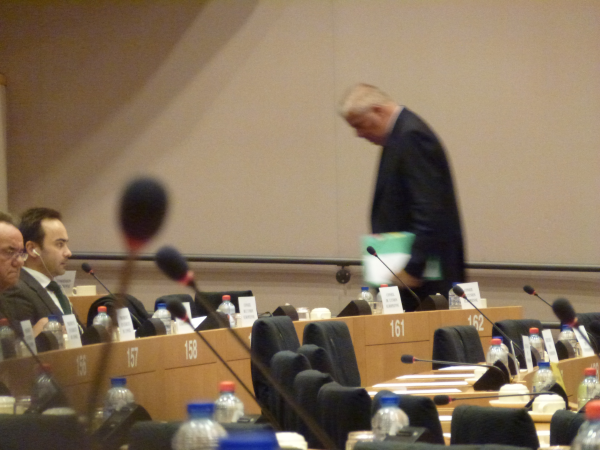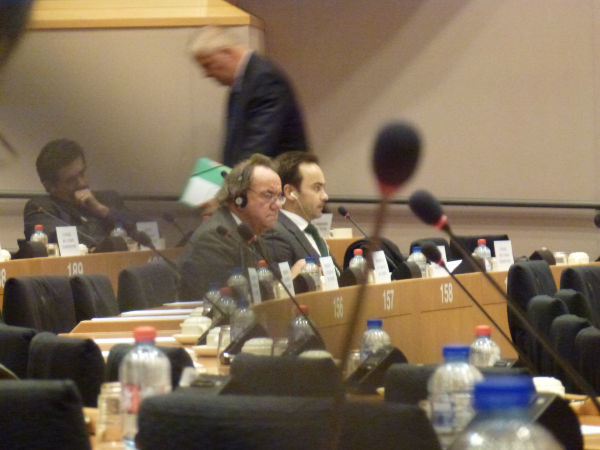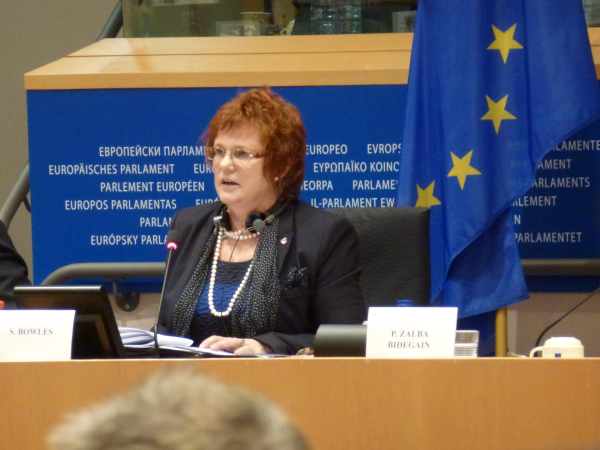COMMENT

Chicken is a kind of a duel in which two people drive straight at each other, careening down a path at high speeds. The person who jumps or steers out of the way first is the ‘chicken’. As neither one is assumed to be crazy enough to actually go through with a crash, the game of chicken is all about bravado. And that is where I believe the trilogue negotiations are. Each side is now pushing the other for final gains and to save face. But everybody knows a deal must be done by the end of the year.
The story so far
Although the trilogue parties did not reach an agreement on 24 October, if you look at what has been said and what has not been said since, you could see where it is going. The debate is also moving on to those other areas that have been put on hold pending an agreement on Long-Term Guarantees (LTG). But first, some facts. The trilogue, which took place on 24 October, was shorter than originally planned. The Presidency (which acts on behalf of the Council in the negotiations) arrived with an agreed position to negotiate the LTG package on behalf of Member States, something that has not happened in the Omnibus II trilogues to date. At the meeting, the European Parliament suggested some changes to the calibration of the Council’s proposal, and introduced (verbally) a list of additional safeguard measures and requirements to the package. There are also outstanding issues both old and new. The old are equivalence and sovereign debt, the new are collectively known as institutional or ‘horizontal’ issues. Ever heard of correlation tables, explanatory documents or Commissions of Enquiry? Nor have I. Until last month I was blissfully unaware of their existence but they have now become part of the Omnibus II trilogue negotiations. Quite an important part.At the trilogue on 24 October
A number of people present at the meeting said the Presidency genuinely believed its proposal would be accepted and was taken aback when that was not the case. This seems to reflect the fact that a number of people involved with the negotiations were highly optimistic an agreement would be reached on the 24th (Solvency II Wire 22/09/2013 & 25/9/2013). A summary document circulated to Member States by the Presidency the following day, and obtained by Solvency II Wire, states, “The EP [European Parliament] indicated that it was not entirely satisfied with Council’s figures.” It asked for the Volatility Adjustment application ratios to be reduced and the Matching Adjustment fundamental spreads to be increased. The Parliament indicated it was “happy” with 15 year transitionals.A list of demands
The Presidency document also states, “Then, the EP presented orally a large list of new measures that it wanted to introduce in the LTG package, relating to both reinforced transparency requirements and to additional prudential measures” (emphasis added). Most notable of these was the insistence to elevate the Credit Risk Adjustment into the Level 1 text.


Burkhard Balz MEP leaving an ECON session on 4 November 2013
Additional safeguards
It is most likely that the LTG package discussed was based on a proposal circulated by the Lithuanian Presidency on 11 October, ahead of the trilogue on the 24th (Solvency II Wire 25/10/2013). The proposal includes a number of measures to enhance the prudential soundness of the LTG package. These include granting the supervisor the ability to limit the impact of transitional measures on technical provisions, as well as a requirement for enhanced supervision during the transitional period. In addition, enhanced monitoring for all the LTG measures is proposed. It is understood that Mr Balz’s list is asking for further measures to be introduced.“I confidently expect Solvency II to be agreed in November”
One cause for optimism about concluding the trilogues soon is the progress that has been made on the LTG. Note also that there have not been any dramatic calls or threats to abandon the discussions. Signals from industry are also increasingly positive. And given industry influence in the process so far, that should count for more than just rhetoric. At the ABI Solvency II conference on 31 October there was an air of almost triumphalism from representatives of the ABI, GDV and FFSA. In his opening address, Hugh Savill, Director of Regulation, ABI said, “Barring any unforeseen accidents I confidently expect Solvency II to be agreed in November.” Quite the change of tone from the ABI’s bi-annual conference, when less than four months ago Nigel Wilson, Group Chief Executive, Legal & General shared that very same stage with Gabriel Bernardino, Chair, EIOPA in what could best be described as a prickly exchange on the value of Solvency II. Bertrand Labilloy, Directeur des Affaires Economiques of the FFSA was also sounding confidently hopeful about an agreement being reached in today’s trilogue, which takes place two days before the FFSA’s own Solvency II conference. “I hope it would be the case, and at lease we could drink champagne in Paris [to celebrate],” he said. Axel Wehlig, Member of the Executive Board of the GDV broadly shared the sentiment. Referring to the LTG package of measures proposed in the trilogues, he said, “We could have seen something better than this but we could have seen also worse than this.” He concurred with Mr Labilloy, saying, “The future is bright and I think most of us are looking forward to have champagne in Paris after a good finalisation of this process in the next trilogue.”Enough is enough
There are now also indications that governments in some of the largest Member States have finally put the brakes on industry demands. According to one EU Official, letters have been sent “at the highest levels” stating that more concessions can not be given on the LTG. Such a factor may help tip the balance to concluding the negotiations as they make it easier for individual Member States and MEPs to negotiate in the Brussels arena.Commission wants a deal
[caption id="attachment_124006" align="alignright" width="270"] European Commission DG MRKT[/caption]
The Commission is also upbeat about getting a deal done. When I visited Mr Wiedner at his office early last week he reiterated its commitment to a prompt conclusion of the trilogues. “We want to conclude the negotiations on the 13th November. We hope that the agreement on LTG and other measures will be acceptable to all parties. I would like to reiterate once again our commitment to the 1 January 2016 entry into force of the Directive,” Mr Wiedner said.
European Commission DG MRKT[/caption]
The Commission is also upbeat about getting a deal done. When I visited Mr Wiedner at his office early last week he reiterated its commitment to a prompt conclusion of the trilogues. “We want to conclude the negotiations on the 13th November. We hope that the agreement on LTG and other measures will be acceptable to all parties. I would like to reiterate once again our commitment to the 1 January 2016 entry into force of the Directive,” Mr Wiedner said.
How the mighty have … been taken down a notch
There are still points of disagreement around the final calibration of the LTG package but these seem to be adjustments rather than the unbridgeable chasms of the past. The proposal circulated by the Lithuanian Presidency on 11 October, suggests setting the application ratio of the Volatility Adjustment (VA) at 65% and the floor for the fundamental spread for the Matching Adjustment at 35% for corporate bonds and 30% for government bonds. You will recall that EIOPA recommended the VA spread to be set at around 20% and the fundamental spreads at around the 75% mark. The measures were discussed in some detail on a panel at the ABI Conference on 31 October 2013, in what was a remarkably candid discussion – quite unusual and to the credit of the officials present – that resembled a trilogue in more ways than one. The panel was chaired by Sharon Bowles MEP, Chair, ECON, who was joined by a member of the European Commission, the UK Treasury, and representatives from both the French and German insurance associations (like I said, resembling a trilogue in more ways than one). Ms Bowles said that the parties were now discussing moving the Credit Risk Adjustment from Level 2 to Level 1 text and raising it from 10bps to 35bps. [caption id="attachment_123993" align="alignleft" width="360"] Sharon Bowles MEP chairing an ECON session on 4 November 2013[/caption]
The change in the Credit Risk Adjustment looks to be one of the key elements of Mr Balz’s list. According to one source, it is being seen as part of a trade off which he is offering the Presidency in which the VA application ratio will be reduced from 65% to 60%; the Parliament is said to still be uncomfortable with some of the calibrations to the LTG package. It is possibly why a number of people have been saying both publicly and privately that the LTG package needs to be taken as a whole.
Andreas Viljoen of the Insurance and Pension Unit at the European Commission, said on the panel that the Commission was cautious on the subject. “It is not a one to one exchange. A certain number of basis points on the one measure doesn’t equal the impact of a certain [number of] basis points on the Credit Risk Adjustment.”
Sharon Bowles MEP chairing an ECON session on 4 November 2013[/caption]
The change in the Credit Risk Adjustment looks to be one of the key elements of Mr Balz’s list. According to one source, it is being seen as part of a trade off which he is offering the Presidency in which the VA application ratio will be reduced from 65% to 60%; the Parliament is said to still be uncomfortable with some of the calibrations to the LTG package. It is possibly why a number of people have been saying both publicly and privately that the LTG package needs to be taken as a whole.
Andreas Viljoen of the Insurance and Pension Unit at the European Commission, said on the panel that the Commission was cautious on the subject. “It is not a one to one exchange. A certain number of basis points on the one measure doesn’t equal the impact of a certain [number of] basis points on the Credit Risk Adjustment.”
“Not the outcome we would have expected to get in an ideal world”
In a telling sign of what is yet to come in today’s meeting (and future meetings?) some political conflict around the LTG measures still remains. Despite his overall optimism, Mr Labilloy, said of the LTG measures, “This is not the outcome we would have expected to get in an ideal world.” He then traced France’s unsuccessful lobbying efforts on the measures, first for an Extended Matching Adjustment, then a simplified Matching Adjustment and then an application ratio of 80% of the one-size-fits-all tool, the Volatility Adjustment. “Now we are with a Volatility Adjustment with an application ratio of 65%. And I would like to say that we can not accept any further reduction of this calibration,” he told the panel. Solvency II Wire has learned that the other Member States, including Italy, are said to be able to can accept an application ratio of 60%. In some worrying way this could be déjà vu (all over again). Last year France was isolated in the trilogues (Solvency II Wire 9/10/2012) and was said to have persuaded the Commission into calling for an impact study, essentially leading to a delay. If history is anything to go by we can expect more on this in the days to come.More hurdles to overcome
Possibly the biggest known obstacle yet to be resolved is the question of third country equivalence. The main problem is what to do with countries that have a regime that is considered prudent but that have stated they don’t intend to seek equivalence with Solvency II. According to Ms Bowles, “The sticking problem that we have is what to do with the United States, which of course is something of enormous concern to industry throughout Europe. And the Parliament is very keen that we have some arrangement that basically doesn’t put at risk European industry.”
The Parliament is seeking temporary equivalence arrangements, while the Commission and Council are said to want to use temporary equivalence as a way to drive these countries to ultimately adopt full Solvency II equivalence and does not support open-ended transitional arrangements.
Another point which was raised at the ABI Solvency II conference is that the UK was still not entirely happy with some of the text of the Matching Adjustment.
The UK is looking to change the text defining the assets that can be held against liabilities in the Matching Adjustment from ‘fixed’ cash flows to ‘predictable’. Indications from Brussels are that all concerned may have less fight in them to pursue this and that other bigger issues are at stake.
According to Ms Bowles, “The sticking problem that we have is what to do with the United States, which of course is something of enormous concern to industry throughout Europe. And the Parliament is very keen that we have some arrangement that basically doesn’t put at risk European industry.”
The Parliament is seeking temporary equivalence arrangements, while the Commission and Council are said to want to use temporary equivalence as a way to drive these countries to ultimately adopt full Solvency II equivalence and does not support open-ended transitional arrangements.
Another point which was raised at the ABI Solvency II conference is that the UK was still not entirely happy with some of the text of the Matching Adjustment.
The UK is looking to change the text defining the assets that can be held against liabilities in the Matching Adjustment from ‘fixed’ cash flows to ‘predictable’. Indications from Brussels are that all concerned may have less fight in them to pursue this and that other bigger issues are at stake.
Hello and welcome to inter-institutional issues
Equivalence and sovereign debt may be big issues, but these are big known issues. A newer and arguably much uglier beast has now reared its head, to the surprise of almost all the people I have spoken with in the past few weeks outside of Brussels. Collectively these issues are being referred to as inter-institutional or horizontal issues. They include things like correlation tables, explanatory texts and Commissions of Enquiry. And according to one EU Official, “The correlation tables have now become an issue of principle for Member States.” I must preface this by saying that this stuff is considered especially complex and admit that I have not gotten to the bottom of all of it, so I will do my best to explain without getting bogged down in legal and technical idiosyncrasies. Essentially this is all about making sure Member States apply the Directive as intended.
Correlation tables and explanatory documents are in essence additional clarifications which Member States have to provide if the Commission is not satisfied with the information initially presented about compliance with a directive.
The minutiae of these issues is almost infinite. In the grand scheme of things they are something which has a history in CRD IV. For those interested, here is a link to the official text published on 17/12/2012.
The inter-institutional issues appear to have turned up on the scene for the first time after the trilogue on 10 September (at least that I am aware of). The Presidency text of 25 October mentions the explanatory documents briefly, “The Presidency and the Council Legal Services expressed concerns on the late EP’s proposal pointing out that it was not a feasible solution as it raised important legal and political issues.”
The issues are not specific to Omnibus II and it is not clear why they were introduced into the negotiations. A number of people familiar with the situation have said it is “Sharon Bowles’ thing”. It is also said that there is some “bad blood” in how they were handled in the CRD IV negotiations.
I must preface this by saying that this stuff is considered especially complex and admit that I have not gotten to the bottom of all of it, so I will do my best to explain without getting bogged down in legal and technical idiosyncrasies. Essentially this is all about making sure Member States apply the Directive as intended.
Correlation tables and explanatory documents are in essence additional clarifications which Member States have to provide if the Commission is not satisfied with the information initially presented about compliance with a directive.
The minutiae of these issues is almost infinite. In the grand scheme of things they are something which has a history in CRD IV. For those interested, here is a link to the official text published on 17/12/2012.
The inter-institutional issues appear to have turned up on the scene for the first time after the trilogue on 10 September (at least that I am aware of). The Presidency text of 25 October mentions the explanatory documents briefly, “The Presidency and the Council Legal Services expressed concerns on the late EP’s proposal pointing out that it was not a feasible solution as it raised important legal and political issues.”
The issues are not specific to Omnibus II and it is not clear why they were introduced into the negotiations. A number of people familiar with the situation have said it is “Sharon Bowles’ thing”. It is also said that there is some “bad blood” in how they were handled in the CRD IV negotiations.
What’s going on
As you can see there are still a few differences to resolve. But in order to understand what is going on we must now return to the game of chicken. In any hard fought negotiation where the parties are evenly matched it is important they can both walk away from the negotiation table with a deal they can claim to have won. It is my view (confirmed to an extent by others closer to the process) that what we are seeing now is a massive display of bravado. Everybody knows the file has to be concluded before the end of the year, and the parties are no longer a million miles away from each other on the issues. Perhaps that is why everybody has been so upbeat, not wanting to be seen to be derailing the process. Catching sight of the end game may explain not only the Parliament’s relatively late introduction of the inter-institutional issues to the trilogues, but also Mr Balz’s list. Some feel that the request to reduce the VA application ratio while offering a long list of counter requests and compromises may be an EP tactic to save face. I would caveat this with one comment. You might conclude from the text so far that the Parliament is the disobliging party in the negotiations, please don’t. In reality the history of Omnibus II is mired in mutual accusations of delay in publication and distribution of texts so it is best to view the latest goings on in that context. The picture that has emerged, at least as of a few days ago, is that now almost all issues have been reduced to the value of a chip in the negotiations. Don’t get me wrong, the LTG is still important, but it is not the omnipotent monster blocking the path to progress, it once was. The situation can perhaps best be summed up by these two quotes from one diplomat, “Who would throw away all of Omnibus II for the sake of correlation tables?” Yet the same person also remarked, “In Omnibus II minor issues can become major issues.”Chasing trilogues
Chasing trilogues is a fun but somewhat futile exercise. Trying to predict their outcome is a mug’s game. Even if there is an agreement today it is unlikely to be conclusive. It is also possible that the parties will agree to come to an agreement in another trilogue. So I hope you will indulge me with one final thought, or vision, which has been lodged in my mind while writing this. I like to think of the trilogue parties sitting around a big round table. In the centre of the table there is a wooden stick supporting a finely balanced bucket. The bucket is full of sludge. Metaphorical sludge. It represents the shame and the incompetence of the inability to come to an agreement on such a vital piece of financial services regulation. The discussions will be hard fought yet likely to reach a conclusion. But at any point anyone can climb onto the table and kick the stick, covering everyone with a shameful stench of failure that is likely to linger for years to come. — To subscribe to the Solvency II Wire mailing list for free click here. ]]>
]]>




